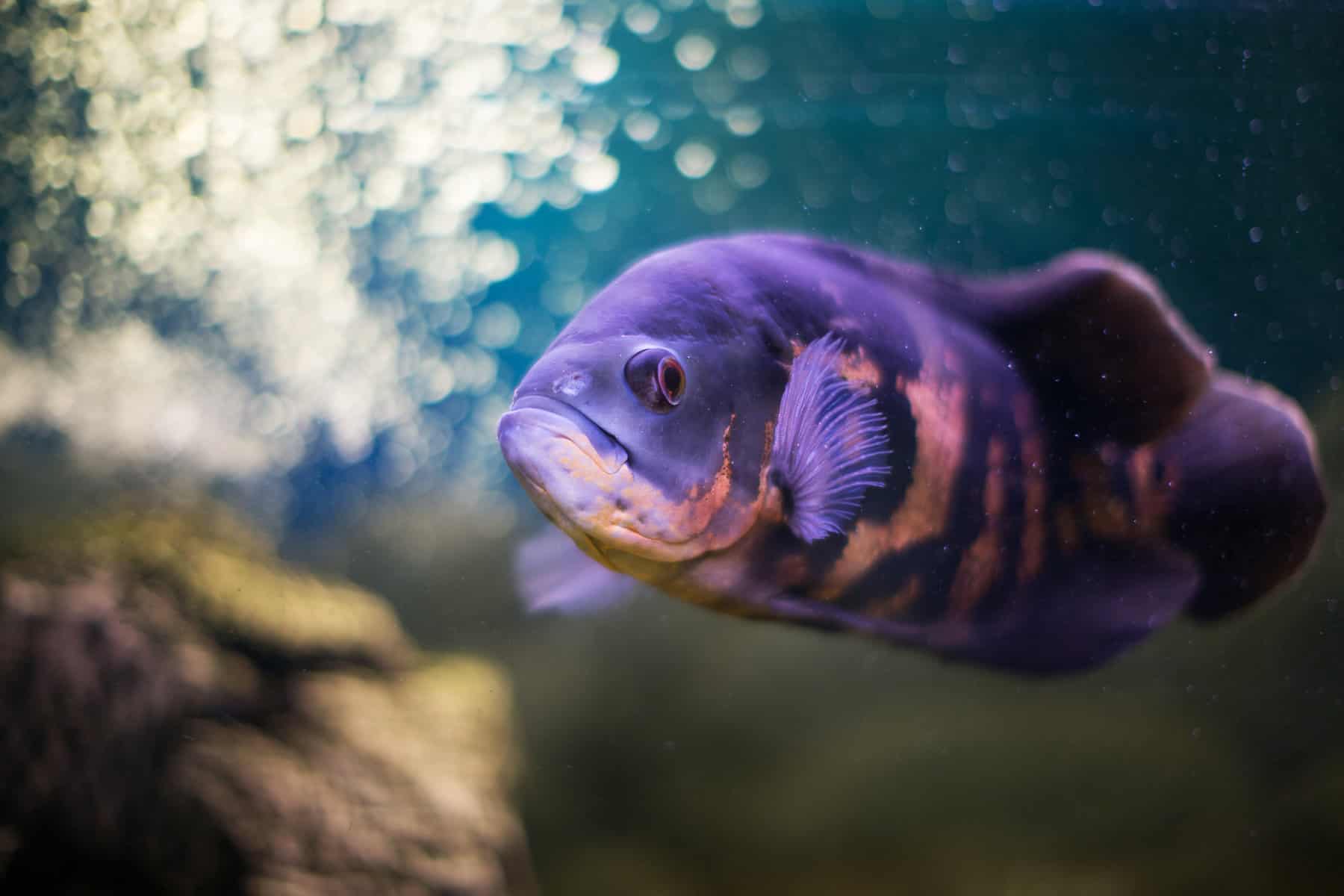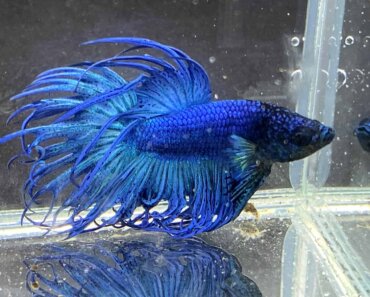Oscar fish are beautiful fish that come in a variety of colors, including albino, white, red, black, blue, green, and tiger.
You might also sometimes come across a Blueberry Oscar for sale online and in some fish stores. But what is a Blueberry Oscar? Should you buy one of these spectacular fish? And how do you care for a Blueberry Oscar?
Read this guide to learn everything you need to know about keeping the rare and beautiful Blueberry Oscar fish.
Blueberry Oscar – Overview
| Blueberry Oscar Info | |
|---|---|
| Scientific name: | Astronotus ocellatus |
| Common names: | Blueberry Oscar, Blue Velvet cichlid |
| Care level: | Challenging |
| Behavior: | Aggressive, territorial |
| Size: | 3 to 4 inches |
| Lifespan: | Only a few months on average |
| Diet: | Omnivore |
| Minimum tank size: | 55 gallons |
| Water temperature: | 74 and 81°F. |
| Water parameters: | pH should be between 6.0 and 8.0, with a water hardness of 5 to 20 dKH. |
What Is a Blueberry Oscar Fish?
A Blue Oscar is a natural color morph of the ever-popular Oscar fish. However, Blue Oscars are very hard to come by and can be pretty pricey to buy.
Blue Oscars are often confused with Blueberry Oscars. But the first thing you must know is that a Blueberry Oscar is a manmade creation, not a natural variant.
Blueberry Oscars are made by dying Albino Oscars blue! The fish are fed food containing blue dye, kept in water stained with blue dye, and injected with blue dye. Horrific!
That process is painful for the fish and results in a lowered immune system, stunted growth, and a much-shortened lifespan.
To make matters worse, the beautiful blue color that first caught your eye typically fades to nothing within three months, assuming your fish lives that long.
Needless to say, we don’t advocate buying a Blueberry Oscar. However, if you do end up with one of these fish by accident, you’ll need to know how to care for it to give it the best chance of a happy, long life.
Origins
Oscars have the scientific name Astronotus ocellatus and belong to the Cichlidae family of fish.
The fish are found in parts of South America, specifically in the Amazon River in Brazil, Ecuador, Peru, and French Guiana.
China and North America also have a few small populations of Oscars, although these fish are thought to be descended from pet fish that were released by their owners, having outgrown their home tanks.
Appearance
Oscars are long, oval-shaped fish with dorsal and anal fins that extend down the fish’s body to its caudal (tail) fin to form a beautiful fan shape.
Male and female Oscars look pretty similar, although close examination of the fish’s genital area can sometimes distinguish between the two sexes.
There are several color variations of Oscars, including blue, red, yellow, green, albino, and black. However, as previously mentioned, the Blueberry Oscar is a purely manmade color morph, not a natural color.
Size
Oscars are usually sold as juveniles of just a few inches long. However, don’t be fooled! These fish will grow to measure around 10 inches long or even more. So, you’ll need a sizeable tank to accommodate them.
Regular Oscars grow extremely rapidly, putting on around 1 inch every month.
That said, Blueberry Oscars typically only survive for a few months, and they tend not to grow much more than their original 3 or 4 inches.
How Long Do Blueberry Oscars Live?
Regular, healthy Oscars can survive in captivity for up to 20 years. However, with a few exceptions, a Blueberry Oscar typically won’t live for more than a few months.
Blueberry Oscar Fish Behavior
All Oscar varieties are extremely territorial in nature and will attack any fish that venture into their home patch. Aggression in Oscars is especially prevalent during spawning and feeding times.
Oscars need a spacious tank to accommodate their size and love to spend time swimming around the central area of the water column. The fish also enjoy rooting around in the substrate for food scraps.
Unfortunately, in a planted tank, that behavior can be problematic, as plants are often uprooted, and decorations tipped over. However, your small Blueberry Oscar won’t be able to inflict as much damage in your tank as a fully-grown adult specimen.
Blueberry Oscar Care Guide
To give your Blueberry Oscar the best chance of living a longer-than-average life, you’ll need to provide your pet with the correct care.
Tank Size
Bearing in mind that Oscars can reach up to 10 inches or more in length, you’ll need a big aquarium to accommodate them.
Generally, we recommend an aquarium of at least 55 gallons for one fish. A tank of that size should be more than adequate for a solitary Blueberry Oscar.
However, if you want to keep more than one of these fish, you’ll need to add a further 20 to 30 gallons to your tank size, especially if the fish you have is a regular, naturally colored variety.
So that the fish have plenty of swimming space, you should choose a long tank rather than a tall one. Oscars can jump if startled, so we recommend a tank with a tightly fitting lid, just in case of accidents!
Tank Setup and Decoration
All fish species do best when housed in an environment that closely replicates their natural habitat.
In the case of Oscars, you want a layer of sandy substrate on the bottom of the aquarium. We recommend a soft substrate rather than coarse gravel, as that might cause injury to your fish when they are searching for food.
You should also provide a few caves so the fish can claim one as its territory. Decorations, including bogwood, pieces of driftwood, twisted roots, smooth stones, and rocks, can give the setup a natural look.
However, we recommend that you securely anchor your decorations, so the fish’s digging doesn’t upend your carefully designed hardscaping.
Plants
All freshwater aquariums benefit from adding a range of living aquatic plants.
Plants help to oxygenate the water through photosynthesis and remove nitrates and CO2 from the water for use as nutrients.
Although your Blueberry Oscar and his companions won’t eat your plants, the fishes’ digging habit can uproot them. You can help to keep the plants securely in situ by using plant weights until the roots become established and not so easily dislodged.
Alternatively, try planting the plants in terracotta pots.
Floating plants, such as Hornwort, make a good choice and will not be so easily disturbed as rooted plants in the substrate.
Lighting System
Oscars do fine with a standard LED lighting system.
However, be sure to check what kind of lighting your plants need and cater to that.
Filtration
Oscars are very large fish that produce a lot of waste. For that reason, we recommend installing a powerful external filter system that produces a good GPH (Gallons Per Hour) flow rate.
Depending on how many fish you have, you might need to supplement the filter system with additional powerheads to generate more current throughout the tank.
Water Parameters
Blueberry Oscars live in warm water and need a temperature of between 74 and 81°F.
The pH should be between 6.0 and 8.0, with a water hardness of 5 to 20 dKH.
Diet and Nutrition
Feeding your Blueberry Oscar a high-quality, balanced diet is essential to give your new pet the best chance of healthy growth and a long life expectancy.
Oscars are pretty easy to cater to, as these omnivores will make a meal out of virtually anything you offer them! Wild Oscar fish eat small fish, insects and larvae, crustaceans, and some plant matter.
We recommend feeding your Blueberry Oscar a diet that includes cichlid flakes and pellets, as well as frozen meaty foods, such as brine shrimp, daphnia, mosquito larvae, and bloodworms.
Can I Feed My Blueberry Oscar Live Foods?
Feeding your Oscar live foods is great since that encourages the fish to hunt for their meals, as they do in nature. However, you should never take critters from the wild environment to feed your fish, and you must use a reputable supplier.
Unfortunately, live foods often carry a cargo of bacteria and parasites that could wreak havoc if they get into your fish tank.
So, unless you plan on keeping a home brine shrimp hatchery, we recommend giving your Oscars frozen meaty proteins instead.
Your Oscar will also enjoy chomping on a few chopped green vegetables, such as lettuce, spinach, and zucchini. Fruits, such as bananas, cantaloupe, oranges, and watermelon, will also be appreciated.
How Often Should I Feed My Blueberry Oscar?
Ideally, you should feed your Blueberry Oscar two or three times a day. Offer your pet what he will eat within a couple of minutes.
As your Blueberry Oscar is likely to be weak and not in the best health, you need to feed him the highest quality diet you can to give him every chance of thriving.
If you have more than one Oscar fish, keep a close eye on them at feeding times. Oscars tend to become aggressive when competing for food, and you don’t want your Blueberry Oscar to miss out or be bullied.
What Fish Can Live With Blueberry Oscars?

As previously mentioned, Oscars are territorial, aggressive fish. For that reason, these fish should ideally live in a single-species aquarium.
However, some large peaceful fish species can make suitable tank mates for Blueberry Oscars, including:
Other large cichlids can make suitable tank mates, as they are big enough to take care of themselves.
However, you should avoid keeping small fish, shrimp, snails, and other invertebrates that could be viewed as a food source by the Oscars.
Can a Group of Oscars Live Together?
If you have a very large tank, a group of different varieties of Oscars can make a spectacular display.
However, be sure that you don’t overcrowd the tank, and provide each fish with its own territory to help prevent aggression.
Can You Breed Blueberry Oscars?
Oscars are extremely challenging to breed in the home aquarium.
In addition, Blueberry Oscars are not a natural color morph, so if you were successful in breeding from your new pet, you’d most likely finish up with a white albino fish.
The other issue with Blueberry Oscars is that they are somewhat fragile and wouldn’t be healthy enough to breed.
Are Blueberry Oscars Hardy?
Regular Oscars are fairly hardy fish, provided they have a balanced, varied diet and are kept in a clean, well-maintained aquarium.
However, Blueberry Oscars are at an immediate disadvantage because of the way in which they are created. As mentioned earlier in this article, your Blueberry Oscar will be more susceptible to attack by parasites and diseases than his naturally colored cousins.
One disease that Oscars are particularly prone to is HITH (Hole-in-the-Head or Oscar Disease).
Hole-in-the-Head (HITH) Disease (Oscar Disease)
HITH disease is thought to be caused by the Hexamita parasite. However, several other aspects of housekeeping can also be contributory factors, such as:
- Poor diet
- Overcrowding
- Vitamin or mineral deficiencies
- Poor water conditions
Oscars with HITH disease display the following symptoms:
- Poor appetite
- Lesions and pitting on the lateral line and head
- Large, weeping sores and holes on the body
- White ulcers around the fish’s eyes and on the top of its head
Unfortunately, HITH disease is usually fatal, especially in fish that are already weak and undersized. However, you could treat your Blueberry Oscar with metronidazole if it still accepts food. If that fails, you could try immersing your Oscar in a metronidazole bath for six to 12 hours.
Other common fish diseases that Blueberry Oscars can suffer from include:
Most of these conditions are exacerbated by poor diet or unsanitary water conditions, both of which can be prevented by good husbandry.
Availability
Blueberry Oscars are often available in fish stores and online.
Whereas regular-colored Oscars retail for around $15 for a fish of 3 to 4 inches long, you can expect to pay more for larger specimens and more unusual colors.
Blueberry Oscars typically sell for $20 or more. However, we do not recommend that you intentionally buy one of these fish for the reasons explained earlier.
Remember, you can buy natural Blue Oscars that have not been artificially colored. Although a Blue Oscar might set you back upwards of $20, you should finish up with a healthy fish that will grow to its maximum size and live a long, healthy life.
FAQs
In this part of our guide, we answer a few of the most commonly asked questions about Blueberry Oscar fish and their care.
Q: How Much Does a Blue Oscar Fish Cost?
A: A genuine Blue Oscar fish costs anywhere between $15 and $40, depending on the fish’s color and size.
Q: What Fruit Can You Feed Oscars?
A: Provided you remove the seeds from the fruit before feeding, Oscars will enjoy fruits, including bananas, cantaloupe, oranges, and watermelon.
Q: What Kind of Fish Is an Oscar?
A: The Oscar (Astronotus ocellatus) is a freshwater fish belonging to the Cichlidae family. Oscars are also sometimes referred to as Velvet or Marble cichlids.
Q: What Fish Can Live With Oscars?
A: Oscars are aggressive fish that need to be kept with other similarly belligerent characters, such as the following:
If you decide to keep other fish with your Oscar, ensure that your tank is large enough to accommodate the fish once they are fully grown. In addition, it’s important to bear in mind that aggressive behavior will be exacerbated if your tank is too cramped and overcrowded.
Q: What Size Tank Do I Need for One Oscar?
A: Oscars grow to around 10 inches long in captivity. So, the minimum tank size for one of these fish is around 55 gallons. However, we recommend a 75-gallon tank as the best option for one adult Oscar.
Final Thoughts
Did you enjoy our guide to Blueberry Oscar fish? If you found the article helpful, please share it before you go!
The Blueberry Oscar fish is a manmade variety that is created by feeding Albino Oscars food containing blue dye, keeping them in water containing dye, and even injecting the poor fish with blue dye.
Generally, Blueberry Oscars only live for a few months, and their artificial color quickly fades. In addition, these fish are usually fragile and prone to diseases, and their growth is stunted.
If you want a Blue Oscar, you can find these naturally colored fish for sale online, although they are quite hard to come by.
Before parting with your cash, always double-check with the pet store that the fish’s color is completely natural and not artificially created.


























